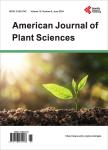Physiological Mechanism of Nitrogen Mediating Cotton (<i>Gossypium hirsutum</i>L.) Seedlings Growth under Water-Stress Conditions
Physiological Mechanism of Nitrogen Mediating Cotton (<i>Gossypium hirsutum</i>L.) Seedlings Growth under Water-Stress Conditions作者机构:Department of Crop Soil and Environmental Sciences University of Arkansas Fayetteville USA. Key Laboratory of Crop Physiology & Ecology in Southern China of Ministry of Agriculture Nanjing Agricultural University Nanjing China
出 版 物:《American Journal of Plant Sciences》 (美国植物学期刊(英文))
年 卷 期:2012年第3卷第6期
页 面:721-730页
主 题:Cotton Seedling Nitrogen Water Deficit Drought Stress Waterlogging Antioxidant Enzyme Activity Photosynthesis Root Vigor
摘 要:The objective of this investigation was to study the effects of nitrogen on tolerance to water-stress in cotton (Gossypium hirsutum L.) seedlings. Growth chamber studies with pots of washed sand were carried out in Fayetteville, USA, and Nanjing, Chinawith three water conditions (well-watered, drought-stressed, and waterlogging), and three nitrogen rates, low nitrogen (16 mM, approximately 224 mg N·l–1 water), medium nitrogen (24 mM, approximately 448 mg N·l–1 water) and high nitrogen (32 mM, approximately 672 mg N·l–1 water), respectively. The results showed that water-stress treatments reduced plant biomass, C/N ratio, root vigor and leaf photosynthesis (Pn). The plant response to water-stress resistance was affected by nitrogen, and was correlated with the activities of antioxidant enzymes. The changes of anti-oxidant enzymes was the highest in the low nitrogen rate in the drought-stressed and waterlogged cotton seedlings. Malondialdehyde (MDA) content increased significantly in the water-stress treatments, and was the lowest in the low nitrogen rate. There was a significant reduction of N accumulation under water stress. Low-nitrogen treatmentincreased C accumulation, while high-nitrogen treatment decreased N accumulation. Root vigor was decreased by water stress, and was highest in the low-nitrogen rate. After terminating the water stress, N application promoted root vigor, especially in waterlogged seedlings. The trends of Pn weresimilarto that of root vigor. These results suggested that low N application may contribute to cotton drought tolerance by enhancing the activity of antioxidant enzymes and conse-quently decreasing lipid peroxidation, and enhancing root vigor. However, higher N should be applied to waterlog- ging-stressed cotton seedlings after terminating waterlogging.



